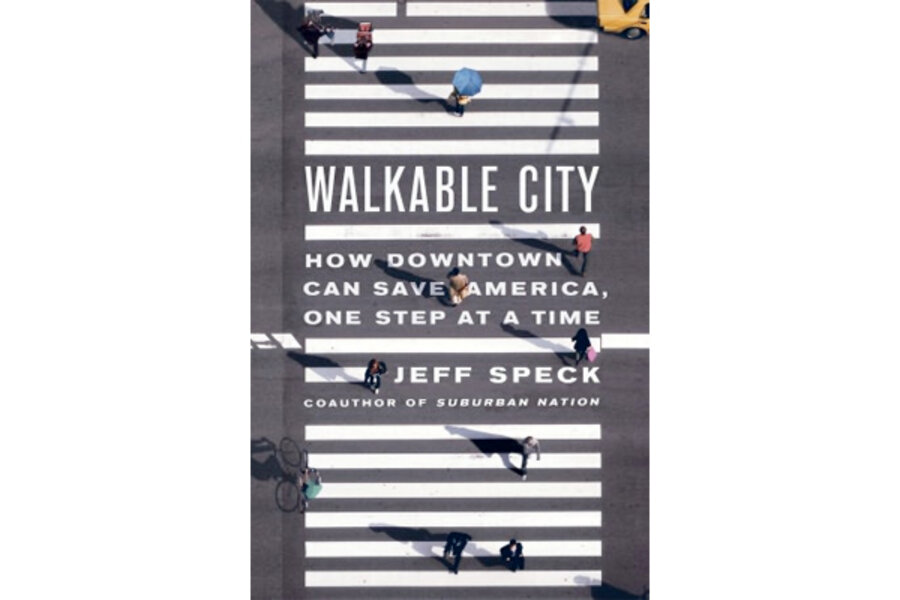Walkable City
Loading...
What’s Rome got – and for that matter Barcelona, Venice, Boston, San Francisco, Paris, Prague, New York – that my hometown does not? Walkability, that’s what! That and, perhaps, a bit more fabric – that is to say, “the everyday collection of streets, blocks, and buildings that tie the monuments [of a place] together.”
It is walkability and fabric that make any urban experience rich and vital.
However, according to Jeff Speck, author of Walkable City: How Downtown Can Save America, One Step at a Time, these features are not exclusive to the world’s great metropolises. Theycan be achieved anywhere ... in 10 basic steps.
In Part I, Speck, who is a city planner, lays out his “General Theory of Walkability” – i.e., a walkable city is a better place than a drivable one. He also explains what is required to make a walk down Main Street compelling and satisfying: utility, safety, comfort, and interest.
He first discusses the advantages that a walkable city has over a drivable one. No. 1 on the list is a “walkability dividend” that nurtures property values. “Not only have city centers fared better than suburbs [since the Great Recession],” Speck says, “but walkable cities have fared better than drivable ones.” Next, there are fitness benefits. “60 percent of residents in a ‘low walkable’ neighborhood were overweight,” notes Speck, “compared to only 35 percent in a ‘high walkable’ neighborhood.”
In Part II, Speck delivers a complete prescription for making cities more walkable with his “Ten Steps of Walkability” formula (see below). Every statistic and fact that Speck includes in this section deserves a double take: “a 10 percent increase in lane miles induces an immediate 4 percent increase in vehicle miles traveled, which climbs to 10 percent – the entire new capacity – in a few years.” In other words, “building new roads [or widening streets] usually makes traffic worse.” And “[c]ities with higher congestion use less fuel per capita, while cities with the least congestion use the most fuel.” In sum: “Congestion is good.” My personal favorite deals with the impact of trees on a neighborhood: “the presence of healthy street trees likely adds $15.3 million to annual property tax revenues.” Plus, the cooling effect of a single healthy tree “is equivalent to ten room-size air conditioners operating 24 hours a day.”
He takes his reader on a stroll down Main Street, slaughtering the sacred cows of city planners and traffic engineers as he goes. Among the surprising claims he makes: Green zones are for the birds, and excess downtown parking is the proverbial kiss of death.
But Speck is wise enough to recognize that following his laws to the letter “would bankrupt most cities.” Sadly, he notes, “the universal application of walkability criteria is simply not in keeping with the way that cities actually work.” However, he suggests, his formula provides a place to start. And for cities needing something fast and cheap, he recommends a first step: “urban triage.” Specifically, fix the downtown. A city’s reputation rests on its downtown; it is “the rising tide that lifts all ships ... a little bit of great downtown can help push a whole city into the great category. That is the place to begin.”
“Walkable City” is timely and important, a delightful, insightful, irreverent work – a book designed to knock us out of complacency and make us aware of the simple but real possibilities. It should be required reading for any city planner, architectural designer, traffic engineer, and, need I say, hapless burgher, like yours truly, who pines for a more ingratiating downtown through which to walk.
Richard Horan is a novelist and nonfiction writer. His most recent book is “Harvest: An Adventure into the Heart of America’s Family Farms.”
10 STEPS OF WALKABILITY:
How to make America's cities more walkable, one step at a time
From: ‘Walkable City,’ by Jeff Speck
1. Put the cars in their place: Put an end to “autocentric” city planning.
2. Mix the uses: Residents should be able to work, shop, eat, drink, learn, recreate, convene, worship, heal, visit, celebrate, and sleep downtown.
3. Get the parking right: There should be less parking that costs more.
4. Let transit work: Make public transit more convenient and comfortable.
5. Protect the pedestrians: Shorter blocks, narrower traffic lanes, and two-way streets favor pedestrians.
6. Welcome bikes: Make cyclists safe and welcome.
7. Shape the spaces: Get the design right.
8. Plant trees: Judiciously planted trees confer numerous benefits.
9. Make friendly and unique faces: Features like awnings and outdoor dining are crowd pleasers.
10. Pick your winners: Be realistic about what will really attract.








